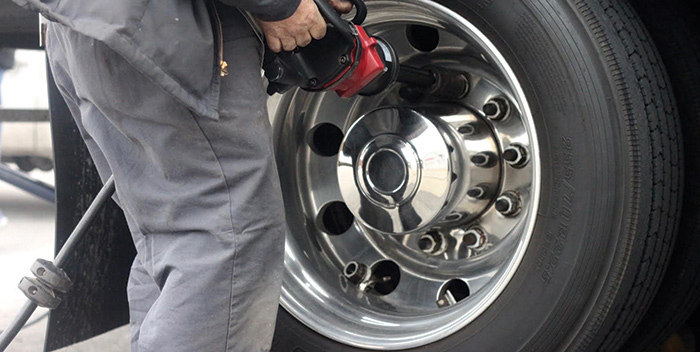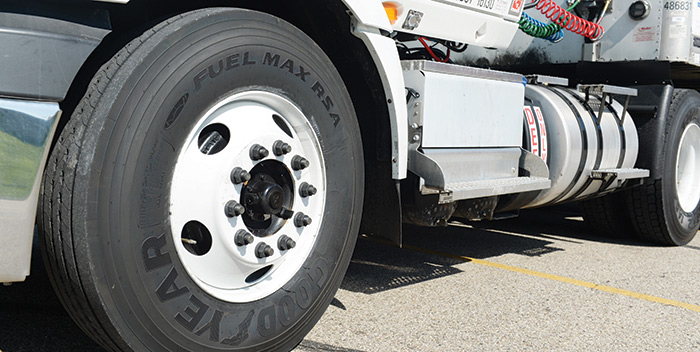There are significant fuel savings to be had by specifying the right tires. Fleet Equipment asked tire makers to weigh in on the tire designs and compounds that can help fleets save fuel.
“Tires are third on the list of the top 10 controllable fuel economy factors,” says Roger Best, project engineer for Bridgestone Tires. “It should be a part of your fuel economy strategy, but it shouldn’t be the only thing that fleet customers consider. Our primary recommendation to fleet managers is that they establish a benchmark for their tire management program. Selecting the right tire for the job, considering the proper tire size, load-carrying capacity, speed capability and service type are important items for all fleet managers to evaluate. At a minimum, fleet managers should identify the average miles that can be expected on each wheel position and application within their fleet, which allows a fleet to identify areas for improvement and create a set of best practices. It also helps budgeting and fleet cost predictions.”
“There are three main areas to consider when designing fuel-efficient tires: tread design, tread compounding and casing construction,” Best explains. “In general, the tread design and compound(s) contribute to about 35 to 50% of a tire’s rolling resistance, while the casing, including the belts, makes up the remaining 50 to 65%. Since about two-thirds of a tire’s rolling resistance is derived from the tread, most efforts to improve tire fuel efficiency focus in this area. Tires with shallower tread designs generate less heat than tires featuring deeper tread designs. This results in lower overall tire temperature and delivers improved fuel economy as less energy is wasted as heat.”
Tread compounding
Tread compounding is another area of focus when designing fuel-efficient tires, Best notes. Most fuel-efficient tires use a “cap and base” design. The cap is the tread compound that comes into contact with the road. Compounds to consider here are those that will provide high resistance to abrasion, long tread life and good traction. The base is directly below the cap and is typically a cooler-running compound. It protects a tire’s casing from heat buildup.
“A tire’s casing construction is the most important component when it comes to determining overall tire life and durability,” Best adds. “A premium truck tire casing can be retreaded multiple times, which helps lower the total cost of ownership and reduce tire expense long-term. Many retreads have fuel-efficient tread designs that also can save the customer money. Retreads have the added benefit of reusing the casing saving energy and reducing landfill waste.”
Fuel-efficient tires on all positions
“Keep in mind a tire’s rolling resistance accounts for 24 to 33% of a vehicle’s power loss, depending on speed,” Best continues. “If we look at a standard 80,000 lb. tractor-trailer with a 53-ft. box trailer, we see that trailer tires account for 43% of fuel consumption, while drive tires are around 39% and steer tires make up approximately 18%. Then there is an 80,000 lbs. tractor-trailer pulling two 28-ft. pup trailers, and the trailer tires account for 64% of fuel consumption, while the drive tires are around 20% and the steer tires make up 16%. Bottom line: tires in the trailer position are the first place to consider for fuel economy improvement related to tires.”
Everything is a factor
“We use every part of the tire in order to balance several performances—one of which is rolling resistance that affects overall fuel efficiency,” says Dr. Prosser Carnegie, head of product development for NAFTA commercial vehicle tires at Continental Tire. “Rubber compounds are one of the main contributing factors to overall fuel efficiency. We focus on the tread compound, since it is a large influence, but with ever increasing demands on fuel economy, we also address the reduction of rolling resistance. Tread design plays a large role in overall rolling resistance since there is a huge contribution to mechanical deformation, which leads to stress points and heat build-up that reduce overall tire fuel efficiency. We ensured that our tread patterns are intrinsic to the overall product and the performance necessary. Several factors can be engineered to relieve this mechanical stress and lead to better overall fuel efficiency. The challenge is balancing the fuel efficiency criteria with other conflicting performances, so that the customer is getting the optimal performance and the lowest overall driving cost.”
Choices
In the past, fleet managers had to make a choice between saving fuel and extending life of their tires because the tread compounds were only able to provide low rolling resistance to improve fuel economy or high mileage. For most fleets, the trade-off was difficult to manage. But now, things have changed.
“In today’s ever-changing market, the technology has caught up and there are tires that strike the proper balance between the two,” Carnegie says. “Fleet managers need to know how their trucks are performing because just placing a fuel-efficient tire in a fleet does not necessarily guarantee a savings. Once the application is determined, a fleet manager can look at the different options of tires and make the best application choices, which could be to focus on fuel, mileage or a hybrid of both. The best way to ensure the fleet achieves its lowest overall driving costs is to combine fuel-efficient tires with a TPMS system.”
Fuel consumption breakdown
“On a normal Class 8 truck/trailer combination, the tires directly contribute to the fuel consumption by about 35%,” Carnegie says. “When we break it down another level, the steer axle is 15% while the drive axle is 42.5% and the trailer axle is also at 42.5% of that contribution. This means that when fleet managers wants to optimize fuel efficiency they should look at balancing their application needs, first on the drive axle and then the trailer axle to see which one provides the most benefit. When these are used together, a fleet will see significant savings in their fuel spending by ensuring that they use a fuel-efficient tire that is designed for their specific application.”
It’s all about rolling resistance
“At its core, truck tire rolling resistance is quantified by the amount of energy lost while rolling,” says Brian Buckham, general manager of product marketing for Goodyear. “A truck tire’s rolling resistance can be impacted by three areas: the hysteric properties of the tire’s rubber compounds, tire tread design and the interaction between the tire’s construction and its mold shape. Since every rubber compound in a tire generates a certain level of rolling resistance, improvements can lower rolling resistance and therefore boost tire fuel efficiency without negatively impacting tire performance.
“In fact,” he continues, “by increasing tread design stiffness, rubber deflection can be minimized, thus lowering the amount of energy lost, reducing the tire’s operating temperature and lowering the tire’s rolling resistance. This also can provide more miles to removal and a longer-lasting casing. In addition, advancements in computer modeling have allowed tire engineers to minimize internal tire stress and strain by optimizing the tire’s construction and its interaction with the molded shape.”
It also should be noted that improper tire maintenance, especially chronic under-inflation, can negate the fuel economy advantages that are gained by low rolling resistance tires.
“Under-inflated tires force truck engines to work harder, thereby consuming more fuel,” Buckham says. “Fleets should check inflation pressures at least once a week using a calibrated tire gauge—more often if possible. Despite that fact that the price of diesel is relatively low at the moment, fuel costs remain a major fleet expense. Even at $2.30 per gallon diesel prices, the potential improvement in fuel economy that a tractor-trailer could achieve versus using non-fuel-efficient tires still greatly outweighs typical cost-per-mile gains in tread wear—sometimes by a three-to-one margin. As a result, fleets should continue to use fuel-efficient tires to help reduce their fuel costs.”
Optimal fuel efficiency starts with accurate tire selection. It is critically important to choose the right fuel-efficient tire for your fleet’s application. First, you must define what your tires will be “asked” to do. Buckham suggests that fleets also keep in mind that you will want to select a tire that effectively minimizes performance trade-offs. In the past, when one performance benefit, such as low rolling resistance, in a particular type of tire was optimized, other benefits, such as traction and tread wear, were negatively impacted. This dynamic is much less prevalent now.
Another thing to remember is that increasingly stringent government regulations for medium- and heavy-duty truck emissions have necessitated the development of “super-fuel” truck tires that go beyond the traditional SmartWay designation. In order to optimize tire investment, which can be considerable, fleets should spec tires that are built on premium casings.
“Buying a premium tire and then retreading its casing will often result in a much lower lifecycle cost over time than opting for a sub-premium tire, which can yield fewer retreads or not be effectively retreaded at all,” Buckham adds. “In today’s hyper-competitive marketplace, retreads also are a viable alternative for cost-conscious fleets.”
Optimizing performance
 For optimal performance benefit, fuel-conscious fleets that spec fuel-efficient tires in one position should follow suit with other wheel positions.
For optimal performance benefit, fuel-conscious fleets that spec fuel-efficient tires in one position should follow suit with other wheel positions.
“In a typical 6×4 18-wheel tractor-trailer combination, all of the tire positions contribute a collective 30% to 33% to the overall fuel-efficiency of the total vehicle, of which steer tires contribute approximately 15%, the drive tires contribute 45% and the trailer tires contribute 40%,” Goodyear’s Buckham says. “It makes sense to use fuel-efficient tires in all 18 positions in order to optimize the tires’ collective contribution to improve miles per gallon. We also recommend that fleets track the performance of their tires in order to optimize fuel economy and overall tire performance.”
Decreasing fuel consumption
“The lower the rolling resistance, the less fuel consumed. In fact, a 3% reduction in rolling resistance can translate into a 1% fuel savings,” says Sharon Cowart, director of product marketing for Michelin Truck Tires. “GHG rules and SmartWay verification also provide interesting new targets. The development of new energy compounds, optimized tread designs, and innovations like the wide base single X One are examples.”
Through tire design, it is possible to utilize technologically advanced compounds and tire construction techniques to minimize a tire’s rolling resistance. In most cases, the depth of a tire’s tread blocks is inverse to rolling resistance. The deeper the tread blocks, the better the grip but the worse for fuel economy. Stiffer sidewalls can also reduce rolling resistance.
“However, there are some design options available that can lower the rolling resistance in areas not related to grip or other performances—internal components, for example,” Cowart says.















